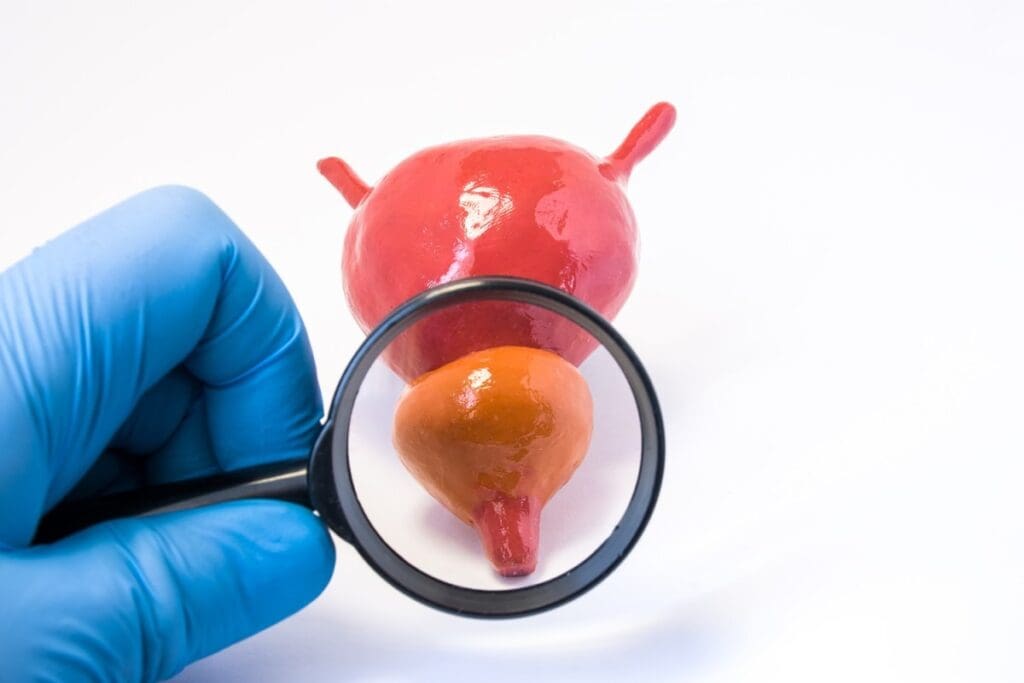Last Updated on October 31, 2025 by
As men get older, their prostate gland grows bigger. Knowing what’s normal is key to staying healthy and preventing problems.

A normal prostate is about the size of a walnut. But it can get bigger with age. By 70, the average prostate size is usually between 43 and 49 cm³. This is much bigger than in younger men.
We will look into why it gets bigger, what it means, and how to handle it.
The prostate gland is key to the male reproductive system. It plays a big role in making seminal fluid. Knowing about the prostate is vital for men’s health.
The prostate gland makes seminal fluid. This fluid nourishes and transports sperm. It’s essential for male fertility. “The prostate gland plays a vital role in the male reproductive system.” It helps sperm survive and move.

The prostate gland is below the bladder and around the urethra. It’s in front of the rectum. Its size and shape affect both urinary and reproductive health. In young men, it’s about the size of a walnut, but it changes with age.
The prostate changes a lot in a man’s life. It grows a lot during puberty. With age, it may get bigger, affecting urine flow. Benign Prostatic Hyperplasia (BPH), or an enlarged prostate, is common in older men. Knowing these changes helps keep the prostate healthy.
As men get older, it’s more important to watch their prostate health. Regular check-ups and staying informed can help catch and manage problems early.
“A healthy prostate is vital for a man’s overall well-being, as he ages.” This shows how important prostate health is for men.
As men get older, knowing the normal prostate size is key, like at 70. The prostate gland is important for men’s health. Its size can show how healthy the prostate is. At 70, the prostate size can differ, but there’s a normal range.
Studies say the average prostate volume for men around 70 is 43 to 49 cm³. This comes from studies on men aged 70-79 and 80-89. For example, one study found men aged 70-79 had a mean prostate volume of 43 cm³. This grew to 49.2 cm³ for men aged 80-89. This growth is common with age and linked to Benign Prostatic Hyperplasia (BPH).

Prostate weight is also a health indicator. The normal prostate weight for men around 70 is similar to the volume. This is because prostate tissue density is consistent. So, a prostate volume of 43 to 49 cm³ would weigh the same in grams, as 1 cm³ of tissue is about 1 gram.
It’s important to know how prostate size changes with age. In younger men (20-40 years), the prostate is much smaller, about 20-25 cm³. As men get older (40-60 years), the prostate starts to grow. By 70, it’s much larger. This growth is natural with age and helps in managing prostate health.
As we age, our bodies change, and the prostate is no exception. “The aging prostate is complex, and knowing its changes is key for men’s health,” say urology experts. Being aware of these changes helps men and their doctors make better health choices.
The size of the prostate gland changes as men age. Knowing these changes helps in keeping an eye on prostate health. We’ll look at how prostate size changes with age, giving a full view of what’s normal.
Young adults, aged 20 to 40, usually have a prostate size of 20-25 cubic centimeters (cm³). This is seen as normal for this age. Prostate size charts show the prostate is smallest here, before it starts to grow with age.
Men in their 40s and 50s often see their prostate grow. This is due to hormonal changes. The prostate can grow to 30-40 cm³ on average. This growth is common and linked to Benign Prostatic Hyperplasia (BPH). But not all men see big changes, and growth can vary a lot.
As men get older, their prostate can keep growing. It’s common for the prostate to grow to 40 cm³ or more by age 60. While some growth is normal, too much can cause urinary problems. Prostate size charts by age help doctors check if a man’s prostate is the right size for his age.
Prostate size varies a lot among men, no matter their age. Charts are helpful but not a full replacement for a doctor’s check-up. Things like genetics, lifestyle, and health can affect prostate size, making it different from the average.
Knowing the normal prostate sizes by age helps men understand their health better. Regular health checks and talking to doctors are key to keeping the prostate healthy and dealing with any size concerns.
As men get older, their prostate often gets bigger. This is mainly because of Benign Prostatic Hyperplasia (BPH). It’s a common problem for older men.
We’ll look at what causes this, like hormonal changes and genetics. This will help us understand why prostate size grows with age.
BPH is when the prostate grows, but it’s not cancer. It happens to almost half of men over 50. By 8age 0, up to 90% of men are affected. Hormonal changes with age are thought to cause it.
Hormonal changes, like testosterone turning into DHT, are key. DHT makes the prostate grow. As men age, DHT levels go up, making the prostate bigger.
Genetics also plays a part. Men with a family history of prostate problems are more likely to get BPH. Knowing this can help manage and prevent it.
Understanding why the prostate grows can help men take care of their health as they age.
Prostate enlargement is common in aging men. But when does it become a health issue? Significant growth can cause urinary problems and affect life quality. Knowing when to worry is key to timely action.
It’s important to tell normal from abnormal prostate growth. Normal enlargement is common with age and is usually harmless. But abnormal enlargement might signal a serious issue that needs medical care.
Abnormal growth can be due to Benign Prostatic Hyperplasia (BPH), hormonal changes, or genetics. These can cause the prostate to grow too much, leading to problems.
Most men over 70 have some prostate enlargement. But only about 4% have a prostate over 100 grams. A prostate over 100 grams often means more severe symptoms and a big impact on life quality.
Men with a large prostate may have weak urine flow, need to urinate often, and wake up at night to pee. These symptoms can really disrupt daily life and happiness.
Knowing the symptoms of a big prostate is important for early treatment. Some common symptoms include:
These symptoms can be upsetting. If you notice them, see a doctor right away. Early check-ups can help find the cause and guide treatment.
Knowing the size of the prostate is key to keeping it healthy. We use many ways to check the size and find any problems. These include simple checks and advanced imaging.
A Digital Rectal Examination (DRE) is a basic test. A doctor feels the prostate gland to look for issues. They can see its size, shape, and feel.
This test gives a good first look at the prostate. But it might not give exact measurements.
Transrectal Ultrasound (TRUS) is more precise. It uses an ultrasound probe in the rectum to see the prostate clearly.
TRUS can measure the prostate’s size accurately. It also spots problems like cysts or tumors.
Magnetic Resonance Imaging (MRI) and Computed Tomography (CT) scanning are advanced tests. They help see the prostate and any issues around it. MRI gives detailed pictures of the prostate and nearby areas.
These tests are vital for finding prostate problems and planning treatment.
Prostate-Specific Antigen (PSA) testing checks PSA levels in the blood. High levels might mean the prostate is too big or has problems. But it doesn’t directly measure size.
PSA testing is used with other tests to better understand prostate health.
In summary, using these methods helps doctors find out the prostate size and spot problems early. Knowing about these tests is important for both doctors and patients to take care of prostate health.
Men with an enlarged prostate have many treatment options. Each has its own benefits and possible downsides. The right treatment depends on how bad the symptoms are, how they affect daily life, and what the patient prefers.
For those with mild symptoms, watchful waiting might be suggested. This means regular visits to the doctor to keep an eye on the condition. The doctor can then adjust the treatment plan as needed.
There are several medicines to help manage enlarged prostate symptoms. These include:
For those needing more than medicine, minimally invasive procedures are a good choice. These include:
When other treatments don’t work, surgical interventions might be needed. The most common surgery for BPH is a transurethral resection of the prostate (TURP). It involves removing extra prostate tissue.
It’s important for men to talk to their doctor about their options. This helps find the best treatment for their specific situation.
Keeping prostate health in check is key for older men to live well. As we get older, knowing what’s normal and spotting problems early is vital. Taking action early can help men deal with prostate issues in their 70s and later.
Getting the right care for prostate health is essential. Places like Livhospital.com offer top-notch urological services. These services help men manage their prostate health, improving their quality as they age.
Dealing with prostate health in older men needs a broad strategy. This includes regular doctor visits, knowing the signs of trouble, and acting fast. By focusing on prostate health, men can avoid serious problems and stay healthy.
At 70, the prostate is usually between 43 and 49 cm³. This is bigger than in younger men because of benign prostatic hyperplasia (BPH).
The prostate size grows a lot with age. Young adults have a small prostate. It gets bigger in middle age and even more in older age.
BPH is a non-cancerous growth of the prostate gland. It’s caused by hormonal changes and genetics. This growth makes the prostate bigger.
Symptoms include trouble starting to urinate and a weak urine flow. You might also need to urinate a lot, even at night. These issues can really affect your life.
Doctors use Digital Rectal Examination (DRE), Transrectal Ultrasound (TRUS), MRI, and CT scans. PSA tests also help check prostate health, even though they don’t measure size directly.
Treatments vary. For mild cases, doctors might just watch and wait. For more severe symptoms, there are medications, procedures, and surgery. The choice depends on how symptoms affect your life and what you prefer.
Size becomes a concern when it’s big enough to cause bothersome urinary symptoms. The 100-gram mark is often seen as a point where symptoms start to be more noticeable.
To manage prostate health, understand normal sizes, and watch for signs of issues. Getting the right care is key. Being proactive and informed helps deal with prostate health challenges in older age.
The prostate size grows with age. It’s small in young adults, gets bigger in middle age, and is usually between 43 and 49 cm³ by 70.
Charts show prostate volume is small in young adults, grows in middle age, and gets even bigger in older age. There’s a lot of variation, with some men being bigger than others.
Subscribe to our e-newsletter to stay informed about the latest innovations in the world of health and exclusive offers!